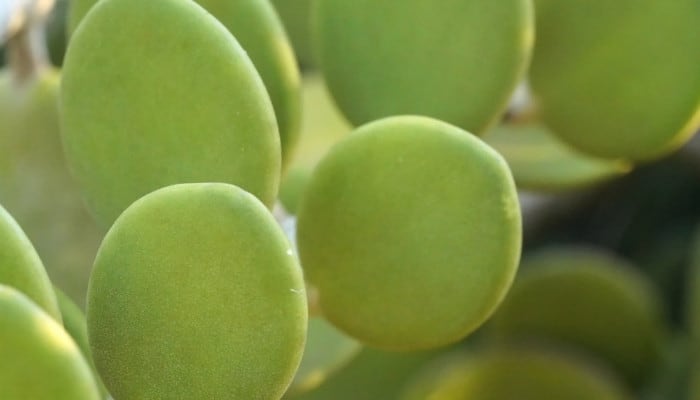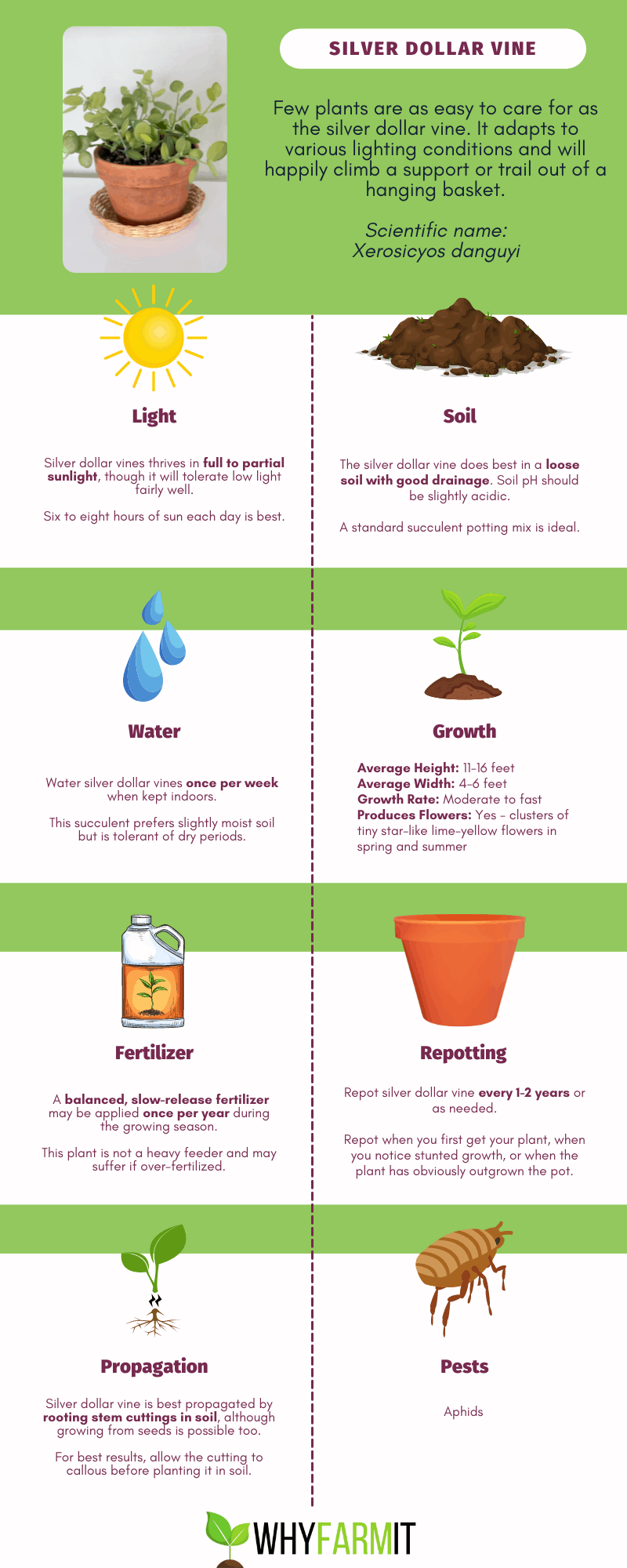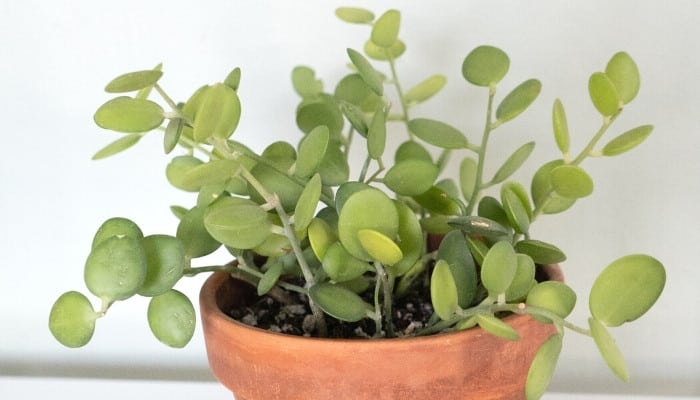The silver dollar vine is a highly stylish succulent that is perfect for both experienced gardeners and beginners with a green thumb.
It’s super easy to grow and thrives indoors and outdoors in warmer climates.
A relative of the cucumber and squash and a member of the Cucurbitaceae family, the silver dollar vine hails from Madagascar’s warm and toasty climes.
A proficient climber, this plant grows well on a trellis or in a container indoors.
How do you care for a silver dollar vine? Keep plant in partial to full sun, and ensure the container has enough drainage holes; the soil should drain well and be allowed to dry out between watering. It will tolerate temperatures of 20-90℉. It requires minimal feeding and should only be fertilized once yearly in the growing season.
Caring For Silver Dollar Vine Basic Guidelines
The silver dollar vine is a happy, friendly climber that will bring a charming aesthetic to your home, office, or garden.
It’s effortless to grow and care for; read on to discover how to keep your silver dollar happy and healthily vining around your heart and home.
Complete Care Guide for Silver Dollar Vine
The silver dollar vine is commonly known as the “string of coins” and penny plant due to the unique coin shape of its leaves, which appear to dangle off either side of its stems like a string of coins.
The leaves can range in color from silver to pale green and even bronze.
Scientifically known as Xerosicyos danguyi, the silver dollar vine is not related to the Lunaria annua.
The confusion is caused by the similar common names given to the Lunaria annua, such as “dollar coin plant” and “money plant.”
Silver Dollar Vine at a Glance
- Scientific Name: Xerosicyos danguyi
- Average Height: 11 – 16 feet
- Average Width: 4 – 6 feet
- Growth Rate: Moderate to fast
- Produces Flowers: Lime-yellow flowers in spring and summer
- Common Pests: Aphids
- Life Expectancy: Evergreen – will last for years with adequate care
- Difficulty of Care: Low
Ideal Soil for Silver Dollar Vine
While tolerant of most soils, the silver dollar vine prefers light soil that provides good drainage with a slightly acidic soil pH of 6.0-6.5.
Silver Dollar Vine Water Requirements
Extremely drought resistant, this succulent prefers slightly moist soil. Water once a week for indoor containers, and provide a deep soaking once a month for outdoor plants.
Outdoor silver dollar vine does not require watering during the winter.
Silver Dollar Vine Lighting Needs
Although the silver dollar can grow in low light, it grows better in full to partial sun. It requires at least six to eight hours of sun each day.
Ideal Temperature and Humidity Range for Silver Dollar Vine
Originating from Madagascar’s warm and temperate climates, the silver dollar grows well in temperatures ranging between 65-85℉.
It can tolerate lower temperatures, but this will cause plant stress. In addition, low humidity levels are preferred to avoid fungal growth and other diseases.
Best Location for Silver Dollar Vine
As heat- and light-seeking as succulents are, a bright spot in the garden or placed in direct light in a bright room or on a windowsill will see your silver dollar vine flourish.
Silver Dollar Vine Growth Habits
The silver dollar vine has a moderate to fast growth rate. The stems produce tendrils that enable the plant to climb and vine, which looks great in hanging containers.
Fertilization Type & Schedule for Silver Dollar Vine
Silver dollar vines don’t require much feeding. Using a balanced slow-release fertilizer, feed once a year during the growing season.
Signs of Nutrient Deficiency
Signs of nutrient deficiency in the silver dollar vine include yellowing leaves, stunted growth, and poor development of secondary shoots.
Usually, this is a sign the succulent is missing necessary nutrients, such as nitrogen, phosphorus, and magnesium.
Pruning Silver Dollar Vine
This plant develops vines at a speedy rate that will require regular pruning to keep the plant in shape and train the vines.
Does Silver Dollar Vine Produce Flowers?
The silver dollar vine produces clusters of tiny star-like lime-yellow flowers in spring and summer. Each plant has either a male or female reproductive system and is considered to be dioecious.
Therefore, plant parents may have either a male or female plant that will require cross-pollination.
Is Silver Dollar Vine Toxic?
The silver dollar vine is considered nontoxic to dogs, cats, and humans. However, it can cause vomiting and depression if ingested by our feline friends.
Silver Dollar Vine Propagation
There are two main methods of propagating the silver dollar vine: cuttings or seed.
The use of cuttings for propagation is pretty popular because it’s so easy to do when pruning the vines.
Propagation is successful when done mid-spring to early summer during the growing period. Avoid propagating in the autumn and winter when growth slows down.
Propagating the Silver Dollar Vine With Stem Cuttings in Soil
This method is the easiest way to produce more silver dollar vine plants.
The tools needed are a pair of sterilized scissors, a container filled with succulent soil mix or well-draining soil, and freshwater. Use rubbing alcohol to sterilize the scissors.
1. Select a Mature Vine With Four to Five Leaves
Using the sterilized scissors, snip a healthy vine from the main stem. Be careful not to cut the main stem as it won’t grow again.
2. Allow the Stem To Callous
Place the stem on clean tissue paper and allow it to dry for two days. The area that was cut will dry or scab over.
Callousing prevents excess water from being absorbed, which may cause rot or disease.
3. Fill the Container With Fresh Succulent Mix or Well-Draining Soil
Fill the container with fresh soil and plant the cutting, pressing down firmly.
4. Water Regularly and Keep the Soil Moist
Water the cutting daily with a small amount of water. Ensure the soil does not dry out; however, avoid making the soil overly moist and soggy.
5. Place the Cutting in Bright, Filtered Light
The tender cutting needs bright but filtered light during propagation—place in a bright area that receives only indirect light.
If you are propagating the plant outdoors, a shade cloth is an excellent option to shelter the plant from the direct sun.
6. New Shoots Can Take Two to Three Weeks To Appear
Shoots can appear before the new roots develop, as this can take a little longer.
Once the plant is established, place the plant in a warm position and provide the same care as you would for the parent plant.
Propagation of Silver Dollar Vine With Seed
You will need the following tools for propagation by seed: silver dollar vine seeds, a container, succulent soil mix, and water.
1. Purchase Seed That Is Free of Disease From a Trusted Supplier
To avoid diseases such as clubroot, purchase silver dollar seeds only from a reputable supplier.
2. Add Potting Soil to the Container
Fill the container 2/3 full with succulent potting mix or light, well-draining soil.
4. Place the Seeds Into the Soil
Ensure the seeds are evenly spaced in the soil, and gently cover with a light covering of soil.
5. Water Thoroughly and Place the Container in a Warm Place
Place the container in a warm room or greenhouse. Ensure that the soil remains moist during germination.
6. Plant in Larger Container Once Seeds Sprout
The seeds take two to three weeks to spout. Maintain a warm temperature of approximately 70℉ during germination.
Repotting Silver Dollar Vine
The purpose of repotting is to provide additional room for root growth and replace old soil that has been depleted of nutrients and no longer holds moisture well.
When To Repot Silver Dollar Vine
Repotting is often required when the plant is purchased from the nursery.After this, follow a repotting schedule of once every two years.
You may need to repot sooner if the plant becomes root-bound as the plant will struggle with nutrient deficiency and poor growth.
The ideal time to repot is mid-spring during the growing season.
Signs That It’s Time To Repot
- Yellow or discolored foliage
- Reduced or stunted growth
- Roots appear through the containers drainage holes
- Dehydration, the foliage looks wrinkled
- Water drains very quickly
How To Repot Silver Dollar Vine
When it’s time to repot your silver dollar vine, collect the basic potting essentials before you start. You will need gardening gloves, a new container, fresh soil, and water.
1. Select a Container Approximately 2-4 Inches Larger
Terracotta pots are excellent for succulents as they provide insulation for the soil protecting the plant from excessive heat and cold.
Ensure the container has suitable drainage holes as succulents hate soggy soil.
2. Carefully Remove the Plant From Its Container
Gently tip the succulent out of its old container, and check for signs of root rot.
3. Loosen the Soil Around the Roots With Your Fingers
Use your fingers to gently loosen the hardened soil around the roots.
4. Half Fill the Container With Fresh Soil or Succulent Potting Mix
Select a well-draining, perlite-based soil or succulent potting mix and fill the new container to the halfway mark.
Place the plant into the pot and fill the pot with fresh soil.
5. Water the Plant and Ensure the Soil Drains Well
Water the plant, and check that the excess water drains well to prevent the soil from becoming boggy. Succulents do not like their roots standing in a pool of water.
Silver Dollar Vine Common Problems & Solutions That Work
Silver Dollar Vine Common Pests & Diseases

The silver dollar is a succulent and, therefore, quite hardy when it comes to pests.
However, it is quite susceptible to disease caused chiefly by excessive moisture and humidity levels.
Aphids
Signs of Trouble
Foliage becomes yellowish and discolored; Aphids leave a sticky honeydew on the leaves that attracts ants and provides the perfect growth conditions for fungi.
Solution
Use a spray bottle filled with water or a hose to blast leaves and dislodge the aphids.
Follow this with a liberal soaking of insecticidal soap (like this ready-to-use soap), focusing on both the upper and undersides of the leaves.
Prevention
Regularly check your plant for signs of aphids.
As a preventative, grow the silver dollar vine near herbs such as dill or fennel as they encourage ladybugs, which are a natural predator of the aphid.
Root Rot
Signs of Trouble
Foliage starts to turn yellow or brownish in color. In addition, growth is stunted, and overall plant health starts to deteriorate. Roots turn black and mushy as they rot.
Solution
Review your watering schedule. While succulents need some water, they require less than most plants and can easily survive drought-like conditions. In fact, they prefer drier conditions.
Trim off affected roots, apply fungicide (find it here), and repot in fresh soil. Begin propagating new plants right away, as root rot often results in death.
Prevention
Water indoor silver dollar vine once a week. Check the soil is not overly moist before applying additional water.
Also, ensure the container has enough drainage holes to prevent the soil from becoming waterlogged.
Septoria Leaf Spot
Signs of Trouble
Freckle-sized holes develop on the leaves and then turn yellow and begin to fall off.
This disease is caused by a fungus called Septoria lycopersici, which lives on decaying plant debris or soil.
Solutions
Remove the infected leaves and dispose of them away from other plants.
Use an organic fungicide, such as copper or potassium bicarbonate to prevent the disease from spreading.
Prevention
Water the Silver dollar at root level to avoid splashing water onto the foliage. Space plants when planting to ensure adequate air circulation.
Clubroot
Signs of Trouble
Leave development is stunted, and foliage begins to turn yellow. Below the ground, the roots develop galls, turn black, and start to rot.
Plasmoidiophorids cause this disease by spreading fungal spores.
Solutions
Remove infected plants immediately to prevent the disease from spreading. Do not add infected plants to the compost pile, as this will aid the spread of the disease.
Test the soil acidity and add lime to increase the pH levels. Some fungicides may help to prevent the development of clubroot, but there is no approved treatment.
Prevention
Purchase plants from trusted suppliers that guarantee the plants to be disease free.
5 Key Tips for Success With Silver Dollar Vine
- Repot biannually to prevent the plant from becoming rootbound.
- Use a grow light to increase light and warmth levels if grown indoors.
- Water once weekly if grown in a container indoors.
- Use terracotta containers to insulate the soil from excessive heat and cold.
- Fertilize with a slow-release fertilizer once yearly in mid-spring.
Conclusion
This lovely ornamental succulent is a gorgeous addition to the home or garden. Its fast-growing vines are happy to trail in the heat of the full sun.
Easy to grow and requiring little in the way of maintenance, it is an excellent plant for beginners.
Simply provide adequate light, a dash of fertilizer once a year, and ensure the soil doesn’t become totally dried out, and your silver dollar vine will happily produce penni-ful vines all year round (see what I did there?).


